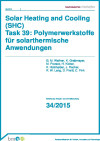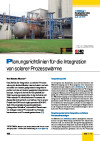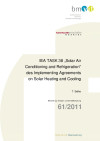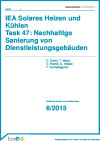Suchergebnisse
Solar Heating and Cooling (SHC) Task 39: Polymerwerkstoffe für solarthermische Anwendungen

Schriftenreihe
34/2015
G. M. Wallner, K. Grabmayer, M. Povacz, H. Kicker, et al.
Herausgeber: BMVIT
Deutsch, 317 Seiten
Downloads zur Publikation
Innovation in all its forms in spotlight at first Energy Innovation Forum at IEA Ministerial (2024)

In den 50 Jahren seit der Gründung der IEA im Jahr 1974 hat sich die globale Landschaft der Energietechnologien verändert - und die Verbreitung der wichtigsten sauberen Energietechnologien ist heute unaufhaltsam. Doch während eine Vielzahl neuer Technologien bereits verfügbar ist, sind Innovationen im Bereich der sauberen Energie notwendiger als je zuvor - und sie müssen beschleunigt werden.
Herausgeber: IEA Bioenergy TCP (2024)
Englisch, 1 Seiten
IEA SHC Task 68: Konferenz ISEC 2022 Beitrag "Automatische Fehlerdetektion für solarthermische Systeme" (2022)

In dem Beitrag für die Konferenz ISEC 2022 werden erste Erkenntnisse aus Subtask B - Daten Verarbeitung und Verwendung zur automatischen Fehlerdetektion von solarthermischen Systemen auf einem Poster vorgestellt.
Lukas Feierl, Thomas Bolognesi, Viktor Unterberger, Manuel Geatani, Bernhard Gerardts
Herausgeber: SOLID Solar Energy Systems GmbH
Englisch, 2 Seiten
Downloads zur Publikation
IEA Bioenergy ExCo 76, IEA Bioenergy Konferenz 2015, CORE-JetFuel Workshop 26. bis 29. Oktober 2015

Dieser Bericht beinhaltet die Zusammenfassung des ExCo Meetings 76, der IEA Bioenergy 2015 Konferenz und des Workshops zum Projekt CORE-JetFuel.
IEA Bioenergy Task 33 Webinar - Gasification: A Crucial Technology for the Energy Transition. A Global Perspective.
24. February 2021
Online, AT
For this webinar speakers from India, China and Europe are invited to share their insights on how gasification is developing as a technology. You will learn on technology developments as well as ongoing R&D in the field of gasification. Gasification is a technology, which can serve many purposes. For the production of heat and power on a small scale, to the production of fuel and chemicals on a larger scale.
IEA SHC Task 59: Experimental measurement of materials drying coefficient for internal insulation: new approaches for laboratory testing (2021)

Experimentelle Messung des Trocknungskoeffizienten von Materialien für die Innendämmung: neue Ansätze für Labortests.
Alexander Rieser, Daniel Herrera -Avellanosa, Eleonora Leonardi, Marco Larcher, Rainer Pfluger, Alexandra Troi
Herausgeber: SBE 21 Heritage Konferenz Bozen
Englisch, 8 Seiten
Conference paper: Assessing Biorefineries Using Wood for the BioEconomy - Current Status and Future Perspective of IEA Bioenergy Task 42 - Biorefining

In Task 42 "Biorefining" werden ausgehend von den Erfahrungen in den 11 teilnehmenden Staaten Lebenszyklus-Bewertungsmethoden (ökonomisch, ökologisch, sozial) bis zu einer umfassenden Nachhaltigkeitsbewertung (LCSA) entwickelt. Die 5 vielversprechendsten Bioraffineriekonzepte mit Holz (wie Hackgut, Sägemehl, Rinde) als Rohstoffe werden mittels der entwickelten Methodik bewertet und die Ergebnisse in einem 'Bioraffinerie Fact-Sheet" zusammengefasst dargestellt.
Report "Techno-economic evaluation of selected decentralised CHP applications based on biomass combustion with steam turbine and ORC processes"

Im vorliegenden Bericht werden die aktuell erfolgreichsten und marktrelevantesten KWK-Technologien auf Basis von Biomasseverbrennung (Dampfturbinen- und ORC-Prozess) untersucht.
IEA Windenergie Task 27: Recommended Practices: Micro Siting Small Wind Turbines For Highly Turbulent Sites (2018)

In den "Recommended Practices" werden Faustregeln und praxisbezogene Empfehlungen zur Ertragsberechnung und Standortbestimmung für Kleinwindkraftanlagen an stark turbulenten Standorten gegeben. Diese sollen sowohl PlanerInnen und ErichterInnen von Kleinwindkraftanlagen dienen als auch EndnutzerInnen und InteressentInnen dieser Technologie.
Ignacio Cruz (CIEMAT, Spanien), Trudy Forsyth (WAT, USA)
Herausgeber: IEA Wind
Englisch, 59 Seiten
Downloads zur Publikation
Working document: "Upgrading Strategies for Industrial Infrastructures - Integration of Biorefineries in Existing Industrial Infrastructure"

Das Working Document beschreibt die Grundlagen, wie zukünftig Bioraffinerien in die bestehende industrielle Infrastruktur integriert werden können, wobei jene Bereiche identifiziert werden, die besonders günstig für die Integration von Bioraffinerien sind.
Mehrsprachig
IEA SHC Task 59: A new decision guidance tool for the adoption of energy retrofit solutions in historic buildings (2021)

Eine neue Entscheidungshilfe für den Einsatz von energetischen Sanierungslösungen in historischen Gebäuden.
Alexander Rieser, Eleonora Leonardi, Franziska Haas, Rainer Pfluger
Herausgeber: SBE 21 Heritage Konferenz Bozen
Englisch, 8 Seiten
IEA Solar Heating and Cooling Task 45: Große Solare Heiz- und Kühlsysteme, Saisonal- speicher, Wärmepumpen

Schriftenreihe
03/2016
S. Putz
Herausgeber: BMVIT
Deutsch, 50 Seiten
Downloads zur Publikation
Artikel: Normung der Charakterisierung von Phasenübergangsmaterialien mittels dynamischer Differenzkalorimetern

Entwicklung standardisierter Messverfahren zur Bestimmung der Enthalpie-Kurven von Phasenwechselmaterialien
Mehrsprachig
Life Cycle Assessment of Future Photovoltaic Electricity Production from Residential-scale Systems Operated in Europe (IEA-PVPS Task 12, May 2015)

Szenario-basierte Information über die Umweltauswirkungen von Monokristallinem Silizium und CdTe Photovoltaik Modulen
IEA PVPS Task 14: International R&D Project Collection - Advanced Cooperation between Distribution and Transmission Network Operation (2018)

Dieser Bericht beinhaltet eine Sammlung internationaler F&E-Projekte mit dem Schwerpunkt auf intelligenten Verfahren, um das Zusammenspiel zwischen TSO und DSO zu steuern. Dazu wurden 19 internationale F&E-Projekte aus den USA, Europa und Japan identifiziert und ihre Ziele, Schlüsselergebnisse und Empfehlungen gesammelt und zusammengefasst.
Herausgeber: IEA PVPS
Englisch, 87 Seiten
Artikel in der Zeitschrift „erneuerbare energie“ 2016-1: Planungsrichtlinien für die Integration von solarer Prozesswärme

Entwicklung eines Integrationsleitfadens zur Integration von solarer Prozesswärme, Definition des geeignetsten Integrationspunktes und des Integrationskonzepts.
Herausgeber: AEE - Dachverband
Deutsch, 4 Seiten
Downloads zur Publikation
GoBiGas: An Industry Relevant State-of-the-Art Reference for Advanced Biofuel Production via Gasification
20. June 2018
Webinar, AT
IEA Bioenergy invites you to participate in this free international webinar. Experiences and advancement made as a result of the first-of-its-kind industrial demonstration of advanced biofuel, in this case methane production via gasification within Göteborg Energi ́s GoBiGas-project, will be summarized.
IEA TASK 38 "Solar Air Conditioning and Refrigeration" des Implementing Agreements on Solar Heating and Cooling

Schriftenreihe
61/2011
T. Selke
Herausgeber: BMVIT
Deutsch, 294 Seiten
Downloads zur Publikation
IEA Solares Heizen und Kühlen Task 47: Nachhaltige Sanierung von Dienstleistungsgebäuden

Schriftenreihe
6/2015
C. Dankl, T. Mach, D. Brandl, S. Holper, T. Ferhatbegovic
Herausgeber: BMVIT
Deutsch, 69 Seiten
Downloads zur Publikation
IEA SHC Task 56: Comparison of simulation results for an office building between different BES tools: the challenge of getting rid of modeller Influence and Identifying Reasons for deviations (2019)

Ziel ist der Aufbau von Referenzmodellen für die (virtuelle) Untersuchung verschiedener solar-passiver und solar-aktiver Fassadensysteme.
Magni, Mara; Ochs, Fabian; Bonato, Paolo; D'Antoni, Matteo; Geisler-Moroder, David; de Vries, Samuel; Loonen, Roel; Maccarini, Alessandro; Afshari, Alireza; Calabrese, Toni (S. 1475 - S. 1482)
Herausgeber: Building Simulation Conference
Englisch, 7 Seiten
